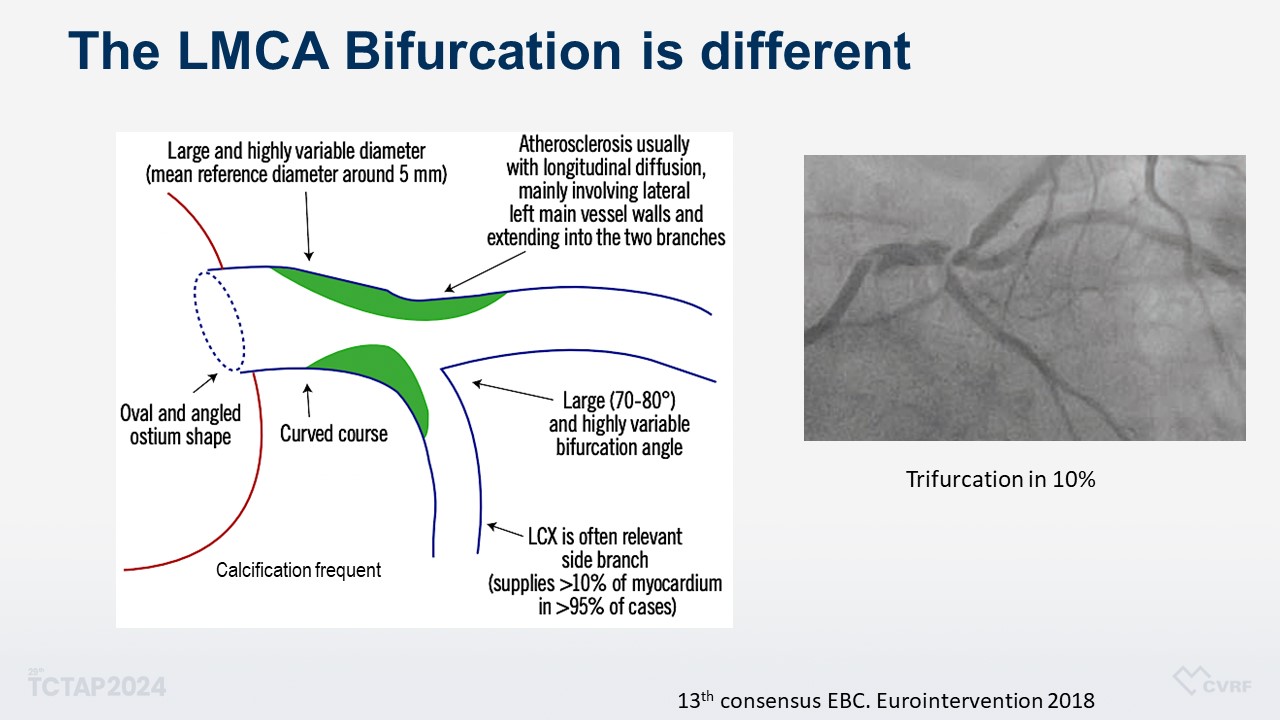
Scott Harding
Wellington Hospital,
New Zealand
Scott Harding, MD (Wellington Hospital, New Zealand) was the first presenter in the °ģNew concept of Bifurcation PCI°Į session, highlighting the unique characteristics of the left main bifurcation compared to other bifurcations (Figure 1). The Left main bifurcation is a larger vessel with crucial branches in almost all cases. Notably, the bifurcation angle (B angle) is generally larger, and there is more calcification and fibrosis, particularly at the circumflex ostium. Additionally, the geometry of the left main bifurcation differs significantly from other bifurcations, such as the left anterior descending (LAD) bifurcation.

Importance of the Circumflex and Myocardial Subtension
Harding stressed the importance of the circumflex artery, which supplies more than 10% of the myocardium in 90% of cases. In contrast, only 20% of the non-left main bifurcations supply a similar amount of myocardium. It was noted that CT estimates might overstate these figures, suggesting that the actual numbers could be lower. He emphasized the critical need to avoid leaving significant disease untreated in the circumflex, citing high event rates over 5 years for patients with low fractional flow reserve (FFR) who did not receive intervention.
Clinical Outcomes: Left Main vs. Non-Left Main Bifurcations
Drawing from various registries, including the Coronary Bifurcation Stent III Registry from Korea, Harding illustrated that left main bifurcation interventions typically result in worse outcomes compared to non-left main bifurcations. This discrepancy is likely due to the larger area of jeopardized myocardium in Left main cases. The complexity of the disease also significantly impacts outcomes, underscoring the importance of comprehensive treatment strategies.
Optimal Stenting Strategies
Harding discussed findings from several trials, including the DKCRUSH-V and EBC MAIN trials, which suggest that complex Left main bifurcations benefit more from a two-stent strategy than a provisional strategy. The DKCRUSH-V trial showed a significant reduction in target lesion revascularization with a two-stent approach, especially in complex lesions (Figure 2). Conversely, the EBC Main trial found a provisional approach to be non-inferior in less complex diseases. These results highlight the necessity of tailoring stenting strategies to the complexity of the lesion.

Unintentional Stent Deformation: Insights from the OCTOBER Trial
An important point from Harding's lecture was the issue of unintentional stent deformation, revealed in the OCTOBER trial. The trial found that 9% of cases experienced unintended stent deformation, with this rate increasing to 19% in left main bifurcations. Factors contributing to this complication include guide catheter collision and abluminal wiring, particularly in complex left main procedures (Figure 3). This finding underscores the need for meticulous attention during stent placement.

Harding concluded by reiterating the differences and challenges associated with left main bifurcation interventions. He noted that the worse outcomes often seen in these cases reflect the large amount of jeopardized myocardium. While a provisional stenting strategy can be effective for most non-left main bifurcations, an upfront two-stent strategy is often warranted for complex left main lesions. These decisions should be guided by the specific characteristics and complexity of the disease.
TCTAP Workshops
New Concept of Bifurcation PCI
Thursday, April 25, 4:00 PM ~ 5:40 PM
Valve & Endovascular Theater, Level 2
Edited by

Yeong Jin Jeong, MD
Sarang General Hospital, Korea (Republic of)
